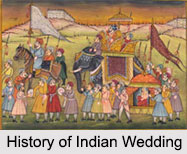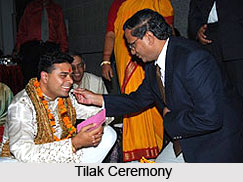Unlike the practice in vogue in other countries, marriage of Indian youths and maidens is arranged and brought about by their elders to wit parents or guardians. The custom of engagement as well as the going through of the preliminary formalities followed in South India is perhaps unique. Parents and guardians of marriageable youths and maidens meet and have a talk. They exchange horoscopes of boys and girls and go to consult astrologers about the suitability of the couple. They also talk about the marriage with reference to the position, etc., of the planets noted in them at the time of their birth. The horoscopes are compared to see in how many of the ten aspects laid down that they suit each other.
These ten aspects can be mentioned as (1) Suitability regarding the day, (2) Suitability regarding the asterism, (3) Suitability regarding the Ganant such as human, deva or rakskasa they are classed under in regard to the asterism they were born under; (4) Suitability regarding the MahSndram or the relationship arising out of the planets the boy and girl were born under; (5) Suitability arising out of Yoni or genital organ which each asterism is assigned and which goes by the name Yonipporutham.
There are certain Yonis that could suit, for example, the Yoni of the elephant and lion cannot suit while the same Yoni for both would suit. Besides the five aspects that are mentioned above there are six more suitability tests the horoscopes are subjected to. These can be noted as Rosipporutham, Rasi Adipathipporuiham, Vasyapporu-tham, Rajjupporutham, Vsdaipporutham, and Nadipporu-iham. In addition to the above suitability tests there are also other tests to which the horoscopes are subjected to. It is impossible to find two horoscopes suiting each other satisfying all the conditions. If at least the most important conditions and some of the other conditions are satisfied, then the astrologers declare that the horoscopes suit and the marriage between the youth and the maiden may be celebrated. The Brahmins trace their descent from one or other of certain specified Rishis and a boy and girl in that line of descent should not marry. This information can be get by knowing the gotra of the concerned persons.
When the parties agree that the marriage between the boy and the girl may be celebrated, they proceed to the discussion of the terms of the marriage. At that point of time they discuss and settle what each side should do to the other side by way of gifts of cash, silver and brads vessels, jewellery and so on. Then they exchange pan supari and the function goes by the name Nichyathambulam. Subsequently, on a day, previously fixed as convenient for both parties, the bride`s party proceed to the residence of the bridegroom`s party with two or three brass plates containing sugar-candy, sugar, bananas, betel, areca nuts, flowers, sandal paste, saffron, etc., and are received by the other party. The villagers as many of them as possible are invited. When all of them are assembled, the bride`s party give out that they have resolved to give the girl so and so to the boy so and so and the boy`s party accept the offer. The terms of the marriage too are given out by the parties and accepted. Cash payments if agreed upon may then be made by one party to the other. Then fruits, sugar, sandal paste, pan supari, etc., are distributed to those present and a feast is held to which not only the boy`s party, but also the villagers are invited. Some times all the villagers are invited while sometimes only a few members get the invitation as well. The leader of the boy`s party is presented with a pair of new cloths as a mark of respect returned.
As the date for the celebration of the marriage is decided upon at the time of meeting prior to the distribution of fruits, etc., and the feast. The bride`s party then return home to make the necessary preparations and arrangements. On the day previous to the wedding the bridegroom is taken in procession to the house kept ready for his reception. The bridegroom`s party occupies that house till the marriage ceremony is over and they are sent off by the bride`s party.
At the time of the Nichitkartkam function the bridegroom`s party should give for the use of the bride a pretty good cloth to wear with half a yard of petticoat cloth. No female cloth should be presented without the addition of a petticoat cloth on any occasion whatever.
As soon as the bridegroom is received in the house provided for his use after due procession, the gentleman who is to give away the bride, presents to the bridegroom a pair of new cloth. After wearing that cloth he has to go through a ceremony called Vratkam. As soon as the Vratham is finished the bridegroom pretends that he is on his way to Benares. Then the bride`s party or rather the one who is to give away the bride meets him and requests him not to go to Benares. He offers to give his daughter or ward as the case may be to him in marriage with a view to make him settle and lead a family life. The bridegroom of course embraces the offer and throws away the paraphernalia of a pilgrim.
He is then taken to the bride`s house and there the girl is gifted over to him. Then with the assistance of the family priest he marries the girl received by him as a gift. after going through certain formalities and marriage rites and ceremonies , the marriage becomes over. When once they are married by the observances of the prescribed rites, nothing can part them and they become husband and wife for life.
Another practice followed is the presentation of cloths to the father-in-law and the mother-in-law both by the bride and the bridegroom`s party. After the marriage is over at the end of four days, the bridegroom and his party are sent off with food, cakes, etc., furnished in plenty to be taken away with them to be made use of on the way. It should not be forgotten that the marriage ceremony takes place in the bride`s house and not in the house of the bridegroom. The bride`s party should look to the comfort and convenience of every one of the bridegroom`s parties during the four or five days of the marriage ceremony. During that time they are their guests. Morning breakfast, midday meal, tiffin and night meal should be provided in a decent scale to the bridegroom`s party by the bride`s party.
This custom is followed by the Brahmins of South India. The other castes may have customs entirely different, but the basic principle that the Hindu marriage is a sacrament and not a contract remains all the same in all cases.



















